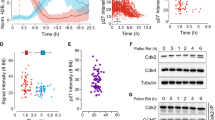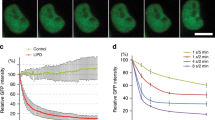Abstract
Using classical genetics to study modular phosphopeptide-binding domains within a family of proteins that are functionally redundant is difficult when other members of the domain family compensate for the product of the knocked-out gene. Here we describe a chemical genetics approach that overcomes this limitation by using UV-activatable caged phosphopeptides. By incorporating a caged phosphoserine residue within a consensus motif, these reagents simultaneously and synchronously inactivate all phosphoserine/phosphothreonine-binding domain family members in a rapid and temporally regulated manner. We applied this approach to study the global function of 14-3-3 proteins in cell cycle control. Activation of the caged phosphopeptides by UV irradiation displaced endogenous proteins from 14-3-3-binding, causing premature cell cycle entry, release of G1 cells from interphase arrest and loss of the S-phase checkpoint after DNA damage, accompanied by high levels of cell death. This class of reagents will greatly facilitate molecular dissection of kinase-dependent signaling pathways when applied to other phosphopeptide-binding domains including SH2, Polo-box and tandem BRCT domains.
This is a preview of subscription content, access via your institution
Access options
Subscribe to this journal
Receive 12 print issues and online access
$209.00 per year
only $17.42 per issue
Buy this article
- Purchase on Springer Link
- Instant access to full article PDF
Prices may be subject to local taxes which are calculated during checkout






Similar content being viewed by others
References
Yaffe, M.B. & Elia, A.E. Phosphoserine/threonine-binding domains. Curr. Opin. Cell Biol. 13, 131–138 (2001).
Lu, P.J., Zhou, X.Z., Shen, M. & Lu, K.P. Function of WW domains as phosphoserine- or phosphothreonine-binding modules. Science 283, 1325–1328 (1999).
Nash, P. et al. Multisite phosphorylation of a CDK inhibitor sets a threshold for the onset of DNA replication. Nature 414, 514–521 (2001).
Elia, A.E., Cantley, L.C. & Yaffe, M.B. Proteomic screen finds pSer/pThr-binding domain localizing Plk1 to mitotic substrates. Science 299, 1228–1231 (2003).
Manke, I.A., Lowery, D.M., Nguyen, A. & Yaffe, M.B. BRCT repeats as phosphopeptide-binding modules involved in protein targeting. Science 302, 636–639 (2003).
Yaffe, M.B. & Smerdon, S.J. PhosphoSerine/threonine binding domains: you can't pSERious? Structure 9, R33–R38 (2001).
Aitken, A. 14-3-3 proteins on the MAP. Trends Biochem. Sci. 20, 95–97 (1995).
Fu, H., Subramanian, R.R. & Masters, S.C. 14-3-3 proteins: structure, function, and regulation. Annu. Rev. Pharmacol. Toxicol. 40, 617–647 (2000).
Tzivion, G. & Avruch, J. 14-3-3 proteins: active cofactors in cellular regulation by serine/threonine phosphorylation. J. Biol. Chem. 277, 3061–3064 (2002).
Jones, D.H., Ley, S. & Aitken, A. Isoforms of 14-3-3 protein can form homo- and heterodimers in vivo and in vitro: implications for function as adapter proteins. FEBS Lett. 368, 55–58 (1995).
Tzivion, G., Luo, Z. & Avruch, J. A dimeric 14-3-3 protein is an essential cofactor for Raf kinase activity. Nature 394, 88–92 (1998).
Yaffe, M.B. et al. The structural basis for 14-3-3:phosphopeptide binding specificity. Cell 91, 961–971 (1997).
Muslin, A.J., Tanner, J.W., Allen, P.M. & Shaw, A.S. Interaction of 14-3-3 with signaling proteins is mediated by the recognition of phosphoserine. Cell 84, 889–897 (1996).
Rittinger, K. et al. Structural analysis of 14-3-3 phosphopeptide complexes identifies a dual role for the nuclear export signal of 14-3-3 in ligand binding. Mol. Cell 4, 153–166 (1999).
Subramanian, R.R., Masters, S.C., Zhang, H. & Fu, H. Functional conservation of 14-3-3 isoforms in inhibiting bad-induced apoptosis. Exp. Cell Res. 271, 142–151 (2001).
Zhang, L., Wang, H., Liu, D., Liddington, R. & Fu, H. Raf-1 kinase and exoenzyme S interact with 14-3-3zeta through a common site involving lysine 49. J. Biol. Chem. 272, 13717–13724 (1997).
Wang, B. et al. Isolation of high-affinity peptide antagonists of 14-3-3 proteins by phage display. Biochemistry 38, 12499–12504 (1999).
Henriksson, M.L. et al. A nonphosphorylated 14-3-3 binding motif on exoenzyme S that is functional in vivo. Eur. J. Biochem. 269, 4921–4929 (2002).
Corrie, J.E.T. & Trentham, D.R. Caged Nucleotides and Neurotransmitters. in Biological Applications of Photochemical Switches (ed. Morrison, H.) 243–305 (Wiley & Sons, New York, NY, 1993).
de Gruijl, F.R. Photocarcinogenesis: UVA vs UVB. Methods Enzymol. 319, 359–366 (2000).
Kleiman, N.J., Wang, R.R. & Spector, A. Ultraviolet light induced DNA damage and repair in bovine lens epithelial cells. Curr. Eye Res. 9, 1185–1193 (1990).
Park, C.-H. & Givens, R.S. New photoactivated protecting groups. 6. p-hydroxy-phenacyl: a phototrigger for chemical and biologcial probes. J. Am. Chem. Soc. 119, 2453–2463 (1997).
Ellis-Davies, G.C. Development and application of caged calcium. Methods Enzymol. 360, 226–238 (2003).
Wootton, J.F. et al. Kinetics of cytosolic Ca2+ concentration after photolytic release of 1-D-myo-inositol 1,4-bisphosphate 5-phosphorothioate from a caged derivative in guinea pig hepatocytes. Biophys. J. 68, 2601–2607 (1995).
Patton, W.F. et al. Mercury-arc photolysis: a method for examining second messenger regulation of endothelial cell monolayer integrity. Anal. Biochem. 196, 31–38 (1991).
Walker, J.W. et al. Signaling pathways underlying eosinophil cell motility revealed by using caged peptides. Proc. Natl. Acad. Sci. USA 95, 1568–1573 (1998).
Vazquez, M.E., Nitz, M., Stehn, J., Yaffe, M. & Imperiali, B. Fluorescent caged phosphoserine peptides as probes to investigate phosphorylation-dependent protein associations. J. Am. Chem. Soc. 125, 10150–10151 (2003).
Ghosh, M. et al. Cofilin promotes actin polymerization and defines the direction of cell motility. Science 304, 743–746 (2004).
Tong, Y. et al. Tyrosine decaging leads to substantial membrane trafficking during modulation of an inward rectifier potassium channel. J. Gen. Physiol. 117, 103–118 (2001).
Rothman, D.M., Vazquez, M.E., Vogel, E.M. & Imperiali, B. General method for the synthesis of caged phosphopeptides: tools for the exploration of signal transduction pathways. Org. Lett. 4, 2865–2868 (2002).
Rothman, D.M., Vazquez, M.E., Vogel, E.M. & Imperiali, B. Caged phospho-amino acid building blocks for solid phase peptide synthesis. J. Org. Chem. 68, 6795–6798 (2003).
Ellis-Davies, G.C.R. & Kaplan, J.H. Nitrophenyl-EGTA, a photolabile chelator that selectively binds Ca2+ with high affinity and releases it rapidly upon photolysis. Proc. Natl. Acad. Sci. USA 91, 187–191 (1994).
Derossi, D., Chassaing, G. & Prochiantz, A. Trojan peptides: the penetratin system for intracellular delivery. Trends Cell Biol. 8, 84–87 (1998).
Dunican, D.J. & Doherty, P. Designing cell-permeant phosphopeptides to modulate intracellular signaling pathways. Biopolymers 60, 45–60 (2001).
Chen, L. et al. Molecular transporters for peptides: delivery of a cardioprotective epsilonPKC agonist peptide into cells and intact ischemic heart using a transport system, R(7). Chem. Biol. 8, 1123–1129 (2001).
Lalande, M. A reversible arrest point in the late G1 phase of the mammalian cell cycle. Exp. Cell Res. 186, 332–339 (1990).
Peng, C.Y. et al. Mitotic and G2 checkpoint control: regulation of 14-3-3 protein binding by phosphorylation of Cdc25C on serine-216. Science 277, 1501–1505 (1997).
Jiang, K. et al. Regulation of Chk1 includes chromatin association and 14-3-3 binding following phosphorylation on Ser-345. J. Biol. Chem. 278, 25207–25217 (2003).
Wang, Y. et al. Binding of 14-3-3beta to the carboxyl terminus of Wee1 increases Wee1 stability, kinase activity, and G2-M cell population. Cell Growth Differ. 11, 211–219 (2000).
Rothblum-Oviatt, C.J., Ryan, C.E. & Piwnica-Worms, H. 14-3-3 binding regulates catalytic activity of human Wee1 kinase. Cell Growth Differ. 12, 581–589 (2001).
Laronga, C., Yang, H.Y., Neal, C. & Lee, M.H. Association of the cyclin-dependent kinases and 14-3-3 sigma negatively regulates cell cycle progression. J. Biol. Chem. 275, 23106–23112 (2000).
Bartek, J. & Lukas, J. Pathways governing G1/S transition and their response to DNA damage. FEBS Lett. 490, 117–122 (2001).
Busino, L. et al. Degradation of Cdc25A by beta-TrCP during S phase and in response to DNA damage. Nature 426, 87–91 (2003).
Ravanat, J.L., Douki, T. & Cadet, J. Direct and indirect effects of UV radiation on DNA and its components. J. Photochem. Photobiol. B 63, 88–102 (2001).
Alberola-Ila, J., Hogquist, K.A., Swan, K.A., Bevan, M.J. & Perlmutter, R.M. Positive and negative selection invoke distinct signaling pathways. J. Exp. Med. 184, 9–18 (1996).
Esteban, L.M. et al. Targeted genomic disruption of H-ras and N-ras, individually or in combination, reveals the dispensability of both loci for mouse growth and development. Mol. Cell. Biol. 21, 1444–1452 (2001).
Dalal, S.N., Schweitzer, C.M., Gan, J. & DeCaprio, J.A. Cytoplasmic localization of human cdc25C during interphase requires an intact 14-3-3 binding site. Mol. Cell. Biol. 19, 4465–4479 (1999).
Ford, J.C. et al. 14-3-3 protein homologs required for the DNA damage checkpoint in fission yeast. Science 265, 533–535 (1994).
Chan, T.A., Hermeking, H., Lengauer, C., Kinzler, K.W. & Vogelstein, B. 14-3-3Sigma is required to prevent mitotic catastrophe after DNA damage. Nature 401, 616–620 (1999).
Chen, M.S., Ryan, C.E. & Piwnica-Worms, H. Chk1 kinase negatively regulates mitotic function of Cdc25A phosphatase through 14-3-3 binding. Mol. Cell. Biol. 23, 7488–7497 (2003).
Acknowledgements
This work was supported by NIH grant GM60594 and a Burroughs-Wellcome Career Development Award to M.B.Y., and the Cell Migration Consortium grant GM64346 to B.I.
Author information
Authors and Affiliations
Corresponding author
Ethics declarations
Competing interests
The authors declare no competing financial interests.
Supplementary information
Supplementary Table 1
Percentage of Cells in S-phase. (PDF 5 kb)
Supplementary Methods
Characterization of individual peptides and additional synthesis details. (PDF 12 kb)
Rights and permissions
About this article
Cite this article
Nguyen, A., Rothman, D., Stehn, J. et al. Caged phosphopeptides reveal a temporal role for 14-3-3 in G1 arrest and S-phase checkpoint function. Nat Biotechnol 22, 993–1000 (2004). https://doi.org/10.1038/nbt997
Received:
Accepted:
Published:
Issue Date:
DOI: https://doi.org/10.1038/nbt997
This article is cited by
-
In vivo spatiotemporal control of voltage-gated ion channels by using photoactivatable peptidic toxins
Nature Communications (2022)
-
Tightening up the structure, lighting up the pathway: application of molecular constraints and light to manipulate protein folding, self-assembly and function
Science China Chemistry (2014)
-
Phospho-Ser/Thr-binding domains: navigating the cell cycle and DNA damage response
Nature Reviews Molecular Cell Biology (2013)
-
14-3-3σ gene silencing during melanoma progression and its role in cell cycle control and cellular senescence
Molecular Cancer (2009)
-
Human 14-3-3 gamma protein results in abnormal cell proliferation in the developing eye of Drosophila melanogaster
Cell Division (2008)



